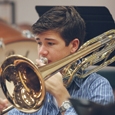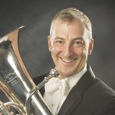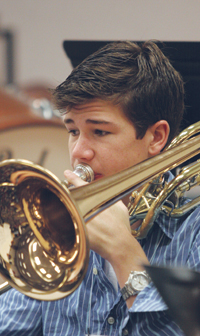 The ability to play slow lip slurs, at all volumes and with consistent tone in all registers, is essential to mastery of low brass instruments. This is a fundamental area of technique that should be practiced by students at all levels, including advanced students. The ability to glide easily from one register to another at various dynamics is important because it allows the performer to play with musical expressiveness, accuracy, and a beautiful tone throughout the entire range of the instrument.
The ability to play slow lip slurs, at all volumes and with consistent tone in all registers, is essential to mastery of low brass instruments. This is a fundamental area of technique that should be practiced by students at all levels, including advanced students. The ability to glide easily from one register to another at various dynamics is important because it allows the performer to play with musical expressiveness, accuracy, and a beautiful tone throughout the entire range of the instrument.
When working on low lip slurs, the goal should be a consistent and beautiful tone quality, no matter the dynamic or register, with fluid movement from note to note. There should be no hairpin dynamics and no uneven beginnings or endings of notes. In moving from one note to another, students should try to avoid producing a bwa, bwa sound. Smears, portamentos, or popping sounds should also be avoided. The purest legato is the goal.
Lip Slur Basics
Low brass players should strive to release a steady stream of air, in a sighing manner. They should avoid releasing too much air. It is unnecessary to send bursts of air or to push the air when moving toward higher notes, and when students do this, it may produce a strident sound in the upper registers. To avoid this problem, remind students that the embouchure, especially the lower lip, should determine pitch, not the air.
Practice on the mouthpiece alone may help in developing the sensation of releasing a steady flow of air. This method of practice has the benefit of avoiding timbre changes from one register to the next. The sound should be robust when practicing with the mouthpiece alone.
Maintaining the sensation of having an open shape in the mouth is helpful. The player should have the sensation of breathing in through a tube or breathing in words like “home.” The inhalation should be soundless. The back of the tongue should stay relaxed during exhalation.
For many years, teachers have debated whether it is helpful to form different syllables such as “ah-ee” in moving from one register up to the next. (An article appearing in The Instrumentalist in 1948 titled “To ‘Ah-ee’ or not to ‘Ah-ee’” considers this question.) I find that, while some slight changes in tongue position may occur when moving from one register to the next, most low brass players will find it unnecessary to use the technique of changing syllables. Rather than helping, I find this technique often causes undue tension in the mouth as it causes the blades of the tongue to press against the molars. This tension can make lip slurs more difficult to perform.
It is good practice to play lip slurs without using a tongue attack. This approach is sometimes referred to as a breath attack. When using this technique, students should try to breathe in the air as if through a tube and then maintain this shape while playing the lip slur. The breath attack helps the player keep this shape, and it prevents the tongue from getting in the way. As slow lip slurs are mastered, the student then should be able to add articulation with the tongue on the initial note, remembering to keep the inside of the mouth in an open shape and the tongue uninvolved in the slurring process.
Excellent posture also helps a great deal in encouraging successful legato and lip slurs. Good posture keeps the air column in place, which leads to a good legato sound; conversely, bad posture or a collapse of the air column will lead to sloppy legato playing and uneven lip slurs. The most obvious problem will be clicking sounds coming from the throat which produce an airing out or a break in the lip slur. Clicks and grunts in the throat can also be the result of articulating with the tip of the tongue rather than from further back where the syllable “en” or “dee” is pronounced.
Playing in front of a mirror using just the mouthpiece is a good way to practice slow lip slurs. When students are able to see what is going on in their playing, they often are able to make necessary adjustments very quickly with little explanation from the instructor. Practice with the mouthpiece alone when playing in front of a mirror will help the student to focus more clearly on the embouchure.
Some students may have difficulty producing a buzz when playing on the mouthpiece. For these students it may help to slightly cover the end of the mouthpiece with a fingertip. This creates a bit more resistance and a sensation similar to what occurs when performing on the instrument.
A helfpul preparatory exercise using only the mouthpiece is to perform portamentos or glissandos up and down from one octave to the next. During this exercise, students should produce a robust buzz with the mouthpiece. The tone production that results should be as consistent as the steady sighing of air that produces it.
In this exercise, and in all practice involving lip slurs, watch for any changes in the embouchure occurring outside of the mouthpiece rim. The only outward change should occur when moving from lower registers to higher registers; this change may be an increased firmness and a slight frown in the corners of the mouth. Practice in front of a mirror will help draw attention to any unnecessary pivoting or up and down movement, as well as any undue movement in the corners of the embouchure.
In the early stages of work on lip slurs, students should try to play lip slurs with the sensation of gliding slowly from one note to the next. As lip slurs are perfected, students should try to play with no audible glissando or smear from one note to the next, although the performer may still have the sensation that this is happening in the embouchure.
Practicing Standard Lip Slurs
The two-note lip slur routinely appears in method books in both descending and ascending form. This is an excellent exercise for beginning work on lip slurs and for developing a consistent tone from one register to the next.
.jpg)
When playing through a series of descending lip slurs, performers should try the following process. First explore breathing without the mouthpiece, maintaining an open mouth with the concept in mind of breathing in through a tube. The player next should release a steady air stream, sighing out the air. This should be practiced first on the mouthpiece alone. Then the player should perform the lip slur in portamento or glissando fashion, still just using the mouthpiece alone. Finally, the student should play the exercise on the instrument, striving to replicate the same sensations that were experienced when using the mouthpiece alone. At this stage, the instrument should simply be the amplifier of what was achieved when using the mouthpiece alone.
This process can be repeated when working through increasingly more advanced lip slurs, such as those that appear in method books.
Eventually, a much more advanced exercise involving lip slurs can be attempted. The exercise below appears in Edward Kleinhammers’s Mastering the Trombone. It involves gradually slurring up two octaves chromatically from the same initial pitch. This exercise can be played beginning on any pitch from which a student can slur two octaves. The exercise should be played pianissimo with the quarter note at sixty beats per minute and breathing where necessary. Some students may try to increase the tempo and volume as they play through the exercise. However, it is important to be consistent with the pianissimo volume and slow tempo so that the focus remains a beautiful tone and fluid movement from note to note.
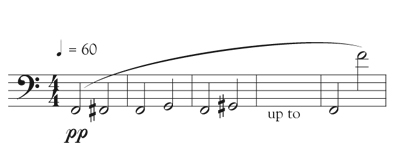
Using Alternate Positions on the Trombone
For trombone students a lip slur using alternate positions is useful. The sensation of sliding from one note to another with alternate positions can then be mimicked on the natural lip slur. No tongue should be used in this exercise, and it is unavoidable that glissandos or slight smears will result on lip slurs when using alternate positions.
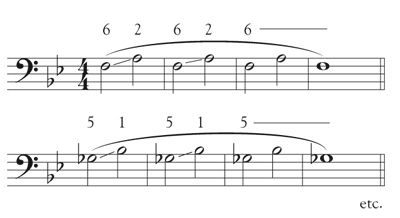
Using Dynamics with Lip Slurs
The exercise below is an excellent way to practice using greater dynamic range during lip slurs. This is best played with a breath attack so that a relaxed embouchre and tongue position is maintained. There should be no increased tension anywhere in the fortissimo. Students should also avoid any sharpening of the pitch in the fortissimo and any flattening of the pitch in the pianissimo. Each note after the breath should begin at exactly the same dynamic that was used at the end of the previous note. The first note should begin as softly as possible, and the last note should end in exactly the same manner.
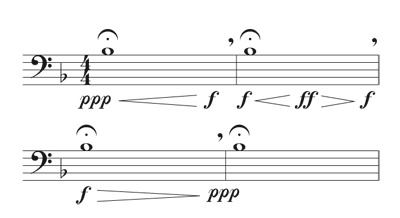
This exercise should be practiced in all ranges and especially on problem notes such as high Bn on the euphonium, the high Ab and G on the trombone, and notes using second and third valve combinations on the tuba. This method can then be applied to actual lip slurs. The example below is adaptations from Max Schlossberg’s Daily Drills and Technical Studies for trumpet. It should be played at a slow to moderate tempo, as should any similar adaptations.
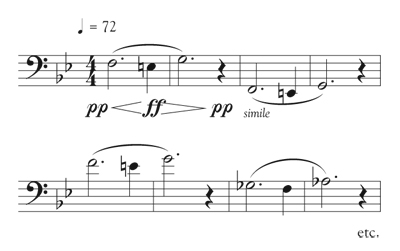
Another useful lip slur is Exercise Number 26 from Schlossberg’s method. This exercise also encourages relaxation in the upper register and discourages using forced air in the upper registers. Students should be sure to move valves and the slide in a quick manner.
Using the F-Attachment and Fourth Valve
Slow lip slurs should be practiced in the notes of the range that require the F-attachment or fourth valve. This helps increase suppleness in the embouchure, as it requires using appropriate lip mass in the embouchure. Upper register pitches always sound better when the lowest registers of a brass instrument have been given proper attention.
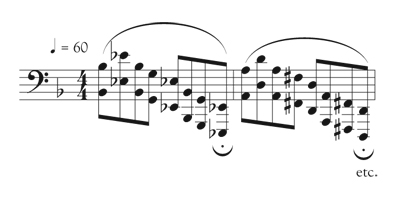
Exercise No. 40 from Schlossberg’s Daily Drills and Technical Studies for Trombone ends with a lip slur that can be played using 7th position or the fingering 1-2-3 on euphonium and tuba. It appears above with extended range, calling for use of the valve attachments on trombone and 4th valve on tuba and euphonium.
A More Complete Toolbox
These methods and exercises will help low brass players perform a fluid legato with consistent tone quality at various volumes. The ability to play slow lip slurs well is an essential tool that students should continue to develop as they strive for total musicianship on a low brass instrument.
